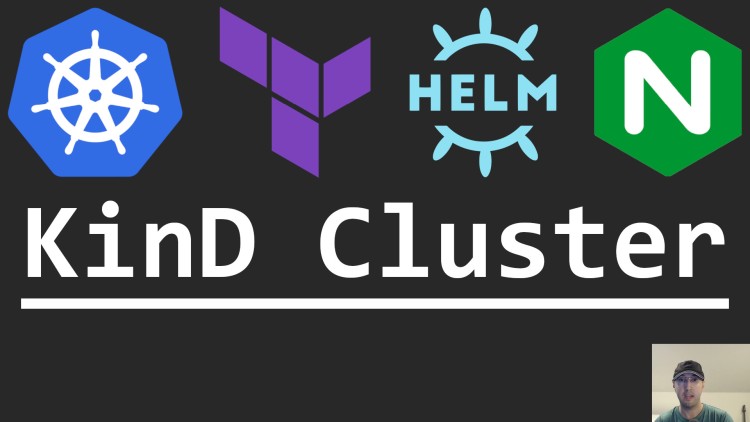Configuring a KinD Cluster with NGINX Ingress Using Terraform and Helm

We'll go over setting up a local Kubernetes cluster that will let you access your services over localhost using the nginx ingress.
Running a multi-node Kubernetes cluster is pretty painless with KinD
(Kubernetes in Docker). It takes about a minute to
spin up a cluster. You could use their kind CLI tool but in my opinion if you
plan to use Terraform in production you should use it in development too. It
saves you from running multiple commands manually or creating a wrapper shell
script.
In production you’d likely use a managed Kubernetes services from your cloud hosting service of choice but for local development this will get you going with a local cluster very quickly. We’ll also go over how to hook up an NGINX Ingress Controller using Helm so you can access your services over localhost.
# Demo Video
Config Files
Here’s all of the Terraform config files covered in the video. The video uses a
different kind provider. Over the years it stopped getting maintained so I
changed this post to use a more up to date version and I also updated all of
the provider versions.
# versions.tf
terraform {
required_providers {
kind = {
source = "tehcyx/kind"
version = "0.2.0"
}
kubernetes = {
source = "hashicorp/kubernetes"
version = "2.22.0"
}
helm = {
source = "hashicorp/helm"
version = "2.10.1"
}
null = {
source = "hashicorp/null"
version = "3.2.1"
}
}
required_version = ">= 1.0.0"
}
# variables.tf
variable "kind_cluster_name" {
type = string
description = "The name of the cluster."
default = "demo-local"
}
variable "kind_cluster_config_path" {
type = string
description = "The location where this cluster's kubeconfig will be saved to."
default = "~/.kube/config"
}
variable "ingress_nginx_helm_version" {
type = string
description = "The Helm version for the nginx ingress controller."
default = "4.7.1"
}
variable "ingress_nginx_namespace" {
type = string
description = "The nginx ingress namespace (it will be created if needed)."
default = "ingress-nginx"
}
# kind_cluster.tf
provider "kind" {
}
provider "kubernetes" {
config_path = pathexpand(var.kind_cluster_config_path)
}
resource "kind_cluster" "default" {
name = var.kind_cluster_name
kubeconfig_path = pathexpand(var.kind_cluster_config_path)
wait_for_ready = true
kind_config {
kind = "Cluster"
api_version = "kind.x-k8s.io/v1alpha4"
node {
role = "control-plane"
kubeadm_config_patches = [
"kind: InitConfiguration\nnodeRegistration:\n kubeletExtraArgs:\n node-labels: \"ingress-ready=true\"\n"
]
extra_port_mappings {
container_port = 80
host_port = 80
}
extra_port_mappings {
container_port = 443
host_port = 443
}
}
node {
role = "worker"
}
}
}
# nginx_ingress.tf
provider "helm" {
kubernetes {
config_path = pathexpand(var.kind_cluster_config_path)
}
}
resource "helm_release" "ingress_nginx" {
name = "ingress-nginx"
repository = "https://kubernetes.github.io/ingress-nginx"
chart = "ingress-nginx"
version = var.ingress_nginx_helm_version
namespace = var.ingress_nginx_namespace
create_namespace = true
values = [file("nginx_ingress_values.yaml")]
depends_on = [kind_cluster.default]
}
resource "null_resource" "wait_for_ingress_nginx" {
triggers = {
key = uuid()
}
provisioner "local-exec" {
command = <<EOF
printf "\nWaiting for the nginx ingress controller...\n"
kubectl wait --namespace ${helm_release.ingress_nginx.namespace} \
--for=condition=ready pod \
--selector=app.kubernetes.io/component=controller \
--timeout=90s
EOF
}
depends_on = [helm_release.ingress_nginx]
}
---
# nginx_ingress_values.yaml
controller:
hostPort:
enabled: true
terminationGracePeriodSeconds: 0
service:
type: "NodePort"
watchIngressWithoutClass: true
nodeSelector:
ingress-ready: "true"
tolerations:
- effect: "NoSchedule"
key: "node-role.kubernetes.io/master"
operator: "Equal"
- effect: "NoSchedule"
key: "node-role.kubernetes.io/control-plane"
operator: "Equal"
publishService:
enabled: false
extraArgs:
publish-status-address: "localhost"
Here’s the ./demo.sh which you can run to create the cluster after running
terraform init:
#!/usr/bin/env sh
set -e
terraform apply -auto-approve
printf "\nWaiting for the echo web server service... \n"
kubectl apply -f https://kind.sigs.k8s.io/examples/ingress/usage.yaml
sleep 10
printf "\nYou should see a timestamp as a response below (if you do the ingress is working):\n"
curl http://localhost/foo
Commands Run
A few commands to interact with the cluster and destroy it:
./demo.sh
kubectl get all -A
terraform destroy -auto-approve
Timestamps
- 0:45 – Initializing Terraform and spinning up the cluster
- 2:30 – Going over a few tools we’ll be using
- 4:44 – Our local cluster is ready to go
- 5:58 – Going over a few required providers
- 7:21 – A couple of variables that we can configure
- 8:48 – Updating the nginx ingress controller to a newer version
- 10:53 – Going over the kind cluster Terraform resource
- 14:41 – Configuring the nginx ingress controller with Terraform
- 19:48 – Creating a null resource with kubectl to wait for the ingress controller
Reference Links
- https://kind.sigs.k8s.io/
- https://github.com/kubernetes/ingress-nginx
- https://github.com/tehcyx/terraform-provider-kind
- https://nickjanetakis.com/blog/using-envsubst-to-merge-environment-variables-into-config-files
- https://github.com/kubernetes-sigs/kind/issues/1693
- https://kubernetes.io/docs/tasks/tools/
Which local Kubernetes cluster tool do you use? Let me know below.